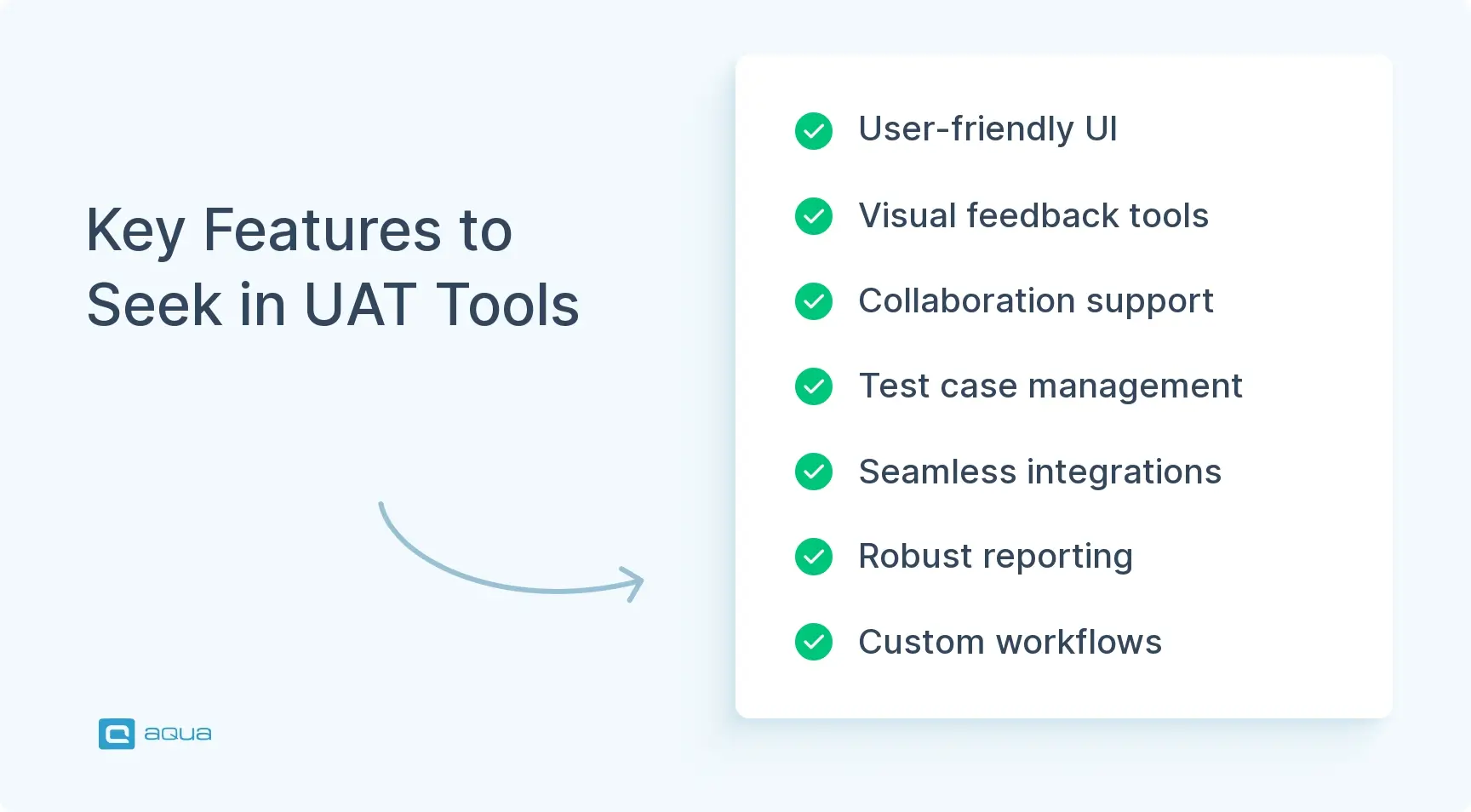Key Takeaways
- User Acceptance Testing (UAT) validates software with real users after technical testing to confirm it meets business requirements and user expectations.
- Tools used for UAT testing organize the testing process by providing central management of test cases, clear communication channels, accountability tracking, and faster issue resolution.
- The right UAT tool depends on your testing type (Alpha, Beta, Operational, Regulatory, or Contract) and specific team requirements.
- Essential UAT tool features include a user-friendly interface for non-technical stakeholders, visual feedback capabilities, collaboration features, and seamless integration with existing workflows.
- Most tools for UAT testing offer free trials, making it crucial to involve actual stakeholders in the evaluation process to ensure the selected tool works for both non-technical users and developers.
Choosing the wrong UAT tool can transform your testing into chaos, while the right one catches critical issues before they become public embarrassments. Discover which tools actually deliver results in the full article below 👇
What is User Acceptance Testing (UAT)?
User Acceptance Testing happens after your technical testing is complete. Real users test the software to verify it handles their actual tasks in real-world scenarios. This isn’t about finding technical bugs anymore. It’s about confirming the software meets business requirements and user expectations.
UAT answers one crucial question:
“Does this software do what users need it to do?”
So what makes UAT different from other testing phases?
- Who conducts it: End users, stakeholders, or client representatives. Not developers or QA teams
- When it happens: After system and integration testing, but before production release
- What it focuses on: Business processes and user workflows rather than technical functionality
- Success criteria: Based on business requirements and user acceptance criteria in testing, rather than just passing test cases
UAT validates that the software delivers value to people who’ll use it every day. It bridges the gap between technical requirements and real-world usability
Often, the completion of UAT is tied to the customer approving the delivery of the product. It tends to be a set of agreed points that need to be delivered, which are determined at the contract stage. UAT would be performed by creating a suite of tests that demonstrate the delivery of each of the agreed-upon points to the customer.
The Importance of UAT Tools
Running UAT without proper tools creates unnecessary chaos. You end up with scattered feedback across emails, incomplete test coverage, and bugs that slip through to production. UAT tools solve these problems by organising the entire testing process.
They address the most common testing challenges:
- Better organisation: Central place to manage test cases, track progress, and document results instead of drowning in spreadsheets and emails
- Clearer communication: Users can report issues with screenshots, annotations, and context rather than vague descriptions that confuse developers
- Improved accountability: See who’s tested what, which requirements are covered, and where gaps exist
- Faster resolution: Bugs get automatically routed to the right people with all necessary details for quick fixes
Without dedicated UAT tools, teams miss critical feedback and release software that doesn’t meet user needs. The right tool transforms UAT from a bottleneck into a valuable development asset.
Types of User Acceptance Testing
Before choosing the right UAT tool, you need to understand which type of testing you’re running. Different UAT approaches require different tool features and capabilities.
Alpha Testing
Alpha testing happens in-house with internal teams who didn’t build the software. It’s your internal reality check before external users see the product.
- Who does it: Internal staff not involved in development
- When: After system testing but before beta testing
- Environment: Controlled in-house environment
- Goal: Catch obvious issues before external users find them
Beta Testing
Beta testing involves real external users trying the software in their actual work environments.
- Who does it: Real end-users or customers
- When: After alpha testing, before final release
- Environment: Users’ actual work environments
- Goal: Gather real-world feedback and find issues that don’t appear in controlled testing
Operational Acceptance Testing
This focuses on whether your IT team can actually support the software once it goes live.
- Who does it: IT operations staff
- When: Runs parallel with other UAT activities
- Focus: Backup/recovery, maintenance procedures, security, and performance
- Goal: Ensure the system can be properly supported in production
Regulatory Acceptance Testing
For regulated industries, this testing verifies that the software meets all compliance requirements.
- Who does it: Compliance specialists and legal teams
- When: Before release in regulated industries
- Focus: Industry standards and regulatory compliance
- Goal: Verify the software meets all legal requirements
Contract Acceptance Testing
This confirms the software meets all criteria specified in client-vendor contracts.
- Who does it: Client representatives
- When: Before final delivery
- Focus: Contract specifications and requirements
- Goal: Ensure all contractual obligations are fulfilled
Each testing type has specific tool requirements. Alpha testing needs internal collaboration features, while beta testing requires external user access and feedback collection. Let’s explore which of the best UAT testing tools handle these different scenarios effectively.
Top User Acceptance Testing Tools
Now that you understand the different UAT approaches, let’s explore the tools that can handle each scenario effectively. The right tool depends on your testing type, team size, and technical requirements.
| Tool | Primary Focus | Best For | Key Features | Pricing Model |
|---|---|---|---|---|
| aqua cloud | AI-powered test management | Modern teams needing intelligent UAT | AI test case generation, customised reporting, comprehensive test management | Tiered subscription |
| Usersnap | Visual feedback collection | Collaborative UAT with non-technical users | Screenshot annotations, in-app feedback, issue tracking | Monthly subscription |
| Marker.io | Bug reporting | Visual feedback and bug tracking | One-click bug reporting, automatic environment capture, Jira integration | Per-user pricing |
| LambdaTest | Cloud testing platform | Scaling UAT across devices | Live testing, automated screenshot testing, responsive testing | Usage-based |
| BugHerd | Visual feedback | Website and app testing | Point-and-click feedback, task board, browser plugin | Team-based pricing |
| UserTesting | User research | Gathering qualitative user feedback | Video recordings of real users, panel recruitment, insight analysis | Enterprise pricing |
| QA Touch | All-in-one testing | Small to mid-sized teams | Test case management, bug tracking, test execution | Tiered subscription |
| Selenium | Test automation | Teams wanting open-source automation | Cross-browser automation, extensive programming language support | Free UAT testing tools (open source) |
| Testpad | Lightweight testing | Agile teams with changing requirements | Checklist-style testing, collaborative testing, simple UI | Per-tester pricing |
| Userlytics | User experience testing | Gathering detailed user feedback | Remote user testing, UX metrics, video recordings | Pay-per-test |
| TestMonitor | Test case management | Client-vendor testing collaboration | Risk-based testing, requirements traceability, intuitive UI | Tiered pricing |
| Azure Test Plans | Microsoft ecosystem | Teams using Azure DevOps | Test planning, execution, exploratory testing, test automation | Azure DevOps add-on |
| Applause | Crowdtesting | Diverse user testing needs | Access to global testing community, managed testing services | Custom pricing |
aqua cloud
aqua cloud combines AI-powered test management with comprehensive UAT capabilities, making it the go-to solution for modern testing teams who want intelligence built into their testing process.
Key Features:
- AI-generated test cases based on requirements and user stories
- Customised reporting with insights and recommendations
- Real-time collaboration tools for distributed teams
- Integration with popular development tools and CI/CD pipelines
- Comprehensive visual defect management with native Capture integration with automated workflows
Ideal For: Teams that want to use AI to make their UAT process more efficient and intelligent, while maintaining full control over test planning and execution.
With aqua’s AI Copilot, you can transform plain-language requirements into complete UAT scenarios in seconds, ensuring nothing gets missed in your testing coverage. What’s more, aqua’s intuitive dashboards provide real-time visibility into your UAT progress, helping teams make informed go/no-go decisions based on actual data rather than gut feelings. Integrations with popular frameworks like Jira, Confluence, Azure Devops and UAT automation tools including Selenium, Jenkins, Ranorex give you the freedom to get the best of both worlds. With full traceability between requirements, test cases, and issues, you’ll always know exactly where your UAT stands.
Save up to 97% of your time while achieving 100% test coverage with aqua cloud
Usersnap
Usersnap specializes in visual feedback collection, making it easy for non-technical users to provide input during UAT.
Key Features:
- Screenshot annotations and visual commenting
- In-app feedback widget
- Automated browser and system information capture
- Issue categorization and priority setting
- Integration with project management tools
Ideal For: Projects where you need to collect feedback from stakeholders who aren’t technically savvy.
Marker.io
Marker.io focuses on streamlining the bug reporting process during UAT, with direct integration to issue tracking systems.
Key Features:
- One-click visual bug reporting
- Automatic environment capture (browser, OS, screen size)
- Direct integration with Jira, Trello, and other tools
- Screenshot annotations and markup tools
- Video recording for reproducing complex issues
Ideal For: Teams looking to eliminate the friction between finding bugs in UAT and getting them into the development backlog.
LambdaTest
LambdaTest is an AI-powered cloud testing platform that allows teams to perform both manual and automated UAT across browsers and devices.
Key Features:
- Live interactive testing on 3000+ browsers
- Automated screenshot testing
- Responsive testing across different screen sizes
- Local testing for staging and development environments
- Integration with CI/CD pipelines
Ideal For: Teams that need both manual exploratory testing and automated UAT testing tools during the validation process.
BugHerd
BugHerd makes it incredibly easy for clients and stakeholders to provide feedback directly on websites during UAT.
Key Features:
- Point-and-click feedback directly on websites
- Task board for organizing and prioritizing feedback
- Browser plugin for quick access
- Visual feedback with screenshots and annotations
- Task assignment and status tracking
Ideal For: Client-facing UAT where non-technical stakeholders need to provide detailed feedback.
UserTesting
UserTesting focuses on gathering qualitative user feedback through recorded testing sessions, providing deep insights during UAT.
Key Features:
- Video recordings of real users testing your application
- Panel recruitment based on your target audience
- Structured test plans and scenarios
- Analysis tools for user feedback
- Highlight reels of key moments
Ideal For: Teams that need to understand not just if users can complete tasks, but how they feel about the experience.
QA Touch
QA Touch is an all-in-one testing platform that combines test case management, bug tracking, and test execution.
Key Features:
- Test case management with reusable test steps
- Bug tracking and management
- Test execution tracking
- Requirements mapping
- Collaboration tools for testing teams
Ideal For: Small to mid-sized teams looking for a comprehensive but affordable testing solution.
Selenium
Selenium is an open-source automation framework that can be used to automate repetitive UAT scenarios, freeing up human testers for more exploratory testing.
Key Features:
- Cross-browser automation
- Support for multiple programming languages
- Integration with CI/CD pipelines
- Extensive community support
- WebDriver protocol for browser automation
Ideal For: Teams with technical resources who want to automate portions of their UAT process.
Testpad
Testpad offers a lightweight, checklist-based approach to testing that’s flexible enough for changing UAT requirements.
Key Features:
- Checklist-style test scripts
- Collaborative testing capabilities
- Simple, intuitive user interface
- Test result sharing and reporting
- Flexible test organization
Ideal For: Agile teams that need a flexible approach to UAT without heavy process overhead.
Userlytics
Userlytics specializes in remote user testing, providing detailed insights into how users interact with your application.
Key Features:
- Remote user testing platform
- User experience metrics and analysis
- Video and audio recordings of test sessions
- Task completion analysis
- Demographic filtering for testers
Ideal For: Teams focused on usability aspects during UAT who need detailed user interaction data.
TestMonitor
TestMonitor specializes in structured, risk-based testing approaches for UAT.
Key Features:
- Risk-based testing methodology
- Requirements traceability
- Intuitive user interface
- Client-friendly test case creation
- Comprehensive reporting
Ideal For: Teams working with external clients who need to demonstrate UAT coverage and results.
Azure Test Plans
Azure Test Plans is Microsoft’s testing solution integrated with Azure DevOps, providing end-to-end testing capabilities.
Key Features:
- Test planning and execution within Azure DevOps
- Manual and exploratory testing tools
- Test automation integration
- Traceability to work items
- Rich reporting capabilities
Ideal For: Teams already using Azure DevOps who want integrated UAT management.
Applause
Applause offers crowdtesting services, providing access to real users for UAT across diverse demographics and devices.
Key Features:
- Access to the global testing community
- Real-world device coverage
- Managed testing services
- Functional and usability feedback
- Demographic targeting options
Ideal For: Teams needing diverse user perspectives during UAT, especially for consumer applications.
Each tool serves different UAT scenarios and team needs. Consider your testing type, team size, technical requirements, and budget when making your choice. The next section will help you navigate these decisions with a practical selection framework.
Key Features to Look For in UAT Tools
You’ve seen the tool options, but choosing the wrong one can turn your UAT process into a nightmare. The difference between a successful UAT and a chaotic mess often comes down to having the right features that actually support how real teams work. Here’s what separates the tools that deliver from the ones that disappoint.
User-Friendly Interface
Your UAT tool will be used by non-technical stakeholders, so complexity kills participation.
- Look for: Clean interfaces with intuitive navigation that anyone can understand
- Avoid: Tools requiring extensive training or technical expertise
- Why it matters: Complex tools reduce participation and lead to incomplete feedback
Visual Feedback Capabilities
Screenshots and annotations eliminate confusion between testers and developers.
- Look for: One-click screenshot capture, annotation tools, and video recording
- Ideal feature: Automatic context capture (browser info, user actions, environment details)
- Why it matters: Visual feedback saves time and prevents miscommunication about issues
Collaboration Features
UAT requires constant communication between testers, developers, and stakeholders.
- Look for: Real-time commenting, @mentions, and task assignment
- Ideal feature: Instant notifications when issues are reported or status changes occur
- Why it matters: Fast communication leads to quicker issue resolution and keeps everyone engaged
Test Case Management
Organised test scenarios ensure comprehensive coverage of your application.
- Look for: Test case creation, organisation, and reuse capabilities
- Ideal feature: Requirements traceability to link test cases with business needs
Why it matters: Structured testing prevents missed functionality and provides clear coverage metrics
As you consider which UAT tool is right for your team, it’s worth asking: what if one solution could combine the best features you’ve seen across multiple platforms? aqua cloud offers exactly that comprehensive approach to UAT with its AI-powered test management system. Unlike basic tools that only handle one aspect of testing, aqua provides end-to-end capabilities from requirements management and test case generation to visual bug reporting and comprehensive analytics. The platform’s AI Copilot can generate complete test scenarios from your requirements in seconds, saving up to 97% of the time typically spent on test case creation. For UAT specifically, aqua excels with its stakeholder-friendly interface, allowing non-technical users to participate easily while maintaining the structure QA professionals need. With seamless integration to tools like Jira and Azure DevOps, and a seamless, native Capture bug-reporting extension, plus custom workflows that match your existing processes, aqua transforms it into a strategic advantage for delivering software your users will actually love.
Turn your UAT from a bottleneck into a competitive advantage with aqua clou
Integration Capabilities
Your UAT tool should connect with your existing development workflow.
- Look for: Connections to bug trackers, project management tools, and development platforms
- Ideal feature: Two-way synchronisation that keeps all systems updated automatically
- Why it matters: Seamless integration eliminates manual data entry and reduces errors
Reporting and Analytics
Clear progress tracking helps stakeholders make informed decisions about release readiness.
- Look for: Customizable dashboards and progress reports
- Ideal feature: Visual indicators showing test completion rates and issue trends
- Why it matters: Transparent reporting keeps everyone informed about UAT status and bottlenecks
Customisation Options
Every team has different processes, and your tool should adapt to yours.
- Look for: Configurable workflows, custom fields, and status options
- Ideal feature: Ability to match the tool’s terminology and processes to your team’s existing practices
- Why it matters: Tools that fit your process get adopted faster and used more effectively
Automation Support
While UAT is primarily manual, automation can handle repetitive verification tasks.
- Look for: Integration with test automation frameworks or built-in automation features
- Ideal feature: Mixed workflows that combine manual exploration with automated checks
- Why it matters: Automation handles routine verification, freeing testers for valuable exploratory work
Focus on tools that excel in the features most critical to your team’s UAT approach. A tool that’s perfect on paper but doesn’t fit your team’s workflow will create more problems than it solves.

Conclusion
The best UAT tool is the one your team actually uses consistently. Start with your biggest pain point and test a few options that address it directly. Most tools offer free trials, so involve your actual stakeholders in the evaluation process. The tool that works smoothly for non-technical users while keeping developers happy is worth more than the one packed with features nobody understands. Good UAT catches real user problems before they become public embarrassments, and the right tool makes that process feel natural rather than forced.


















